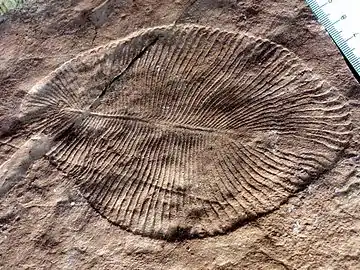Avalon explosion
The Avalon explosion, named from the Precambrian fauna of the Avalon Peninsula, is a proposed evolutionary radiation in the history of the Animalia, about 575 million years ago, some 33 million years earlier than the Cambrian explosion.

Evidence

Trace fossils of these Avalon organisms have been found worldwide, and represent the earliest known complex multicellular organisms.[lower-alpha 1] The Avalon explosion produced the Ediacaran biota.[1][2] The biota largely disappeared contemporaneously with the rapid increase in biodiversity known as the Cambrian explosion.
The Avalon explosion appears similar to the Cambrian explosion in the rapid increase in diversity of morphologies in a relatively small time frame, followed by diversification within the established body plans,[2][3] a pattern similar to that observed in other evolutionary events.[3]
History
The Avalon explosion was proposed in 2008 by Virginia Tech paleontologists through the analysis of the morphological space change in several Ediacaran assemblages.[2] The discovery suggests that in the early evolution of animals, there may have been more than one explosive event.[4] The original analysis has been the subject of dispute in the literature.[5][6][7]
References
- "Two Explosive Evolutionary Events Shaped Early History Of Multicellular Life" (Press release). Virginia Tech. January 4, 2008. Retrieved 2018-03-06 – via ScienceDaily.
- Shen, Bing; Dong, Lin; Xiao, Shuhai; Kowalewski, Michał (4 January 2008). "The Avalon Explosion: Evolution of Ediacara Morphospace". Science. 319 (5859): 81–84. Bibcode:2008Sci...319...81S. doi:10.1126/science.1150279. ISSN 0036-8075. PMID 18174439.
- Xiao, Shuhai; Laflamme, Marc (January 2009). "On the eve of animal radiation: phylogeny, ecology and evolution of the Ediacara biota". Trends in Ecology & Evolution. 24 (1): 31–40. doi:10.1016/j.tree.2008.07.015. PMID 18952316.
- "The Avalon Explosion". Astrobiology Magazine. 8 January 2008. Retrieved June 14, 2012.
- Freeman, Gary (2009). "The rise of bilaterians". Historical Biology. 21 (1–2): 99–114. doi:10.1080/08912960903295843.
- Xiao, Shuhai; Kowalewski, Michał; Shen, Bing; Dong, Lin; Laflamme, Marc (8 January 2010). "The rise of bilaterians: a reply". Historical Biology. 21 (3–4): 239–246. doi:10.1080/08912960903471659.
- Freeman, Gary (30 Jun 2010). "Comment on Xiao et al. (2009), response to: the rise of bilaterians". Historical Biology. 22 (4): 430–432. doi:10.1080/08912960903562259.